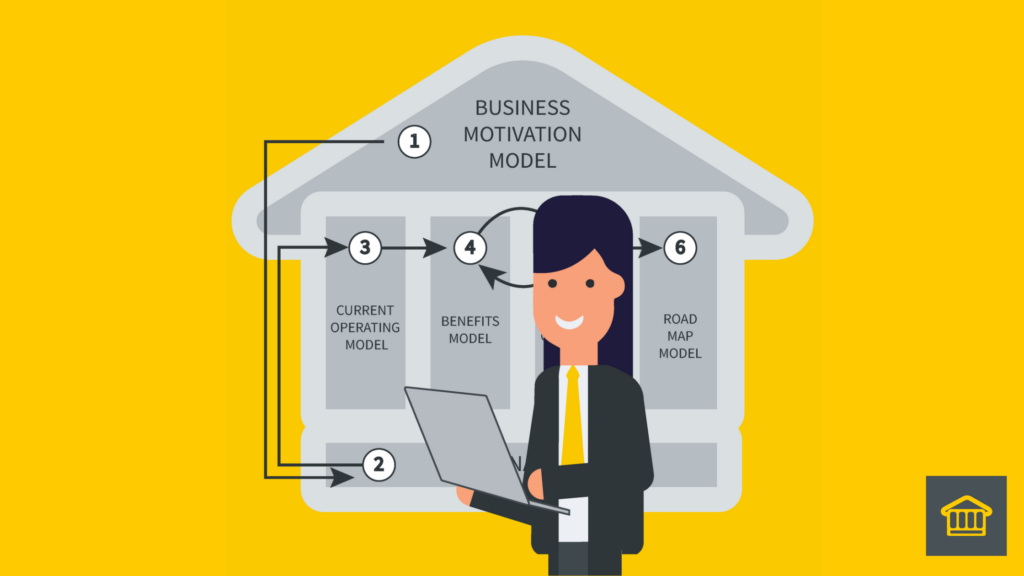In today’s fast-paced and ever-evolving business environment, organisations must continually adapt to remain competitive.
Business transformation is a critical process that enables companies to realign their operations, strategies, and structures to achieve significant improvements and meet new market demands.
However, this transformation is complex and requires a structured approach to ensure success.
One such structured approach is the House of Business Architecture (HOBA) business transformation framework.
Developed over 15 years and first published in “The Business Transformation Playbook” in 2018, HOBA has been utilised by private clients, including the UK government, and is now used globally by tens of thousands of practitioners and hundreds of companies.
This guide provides an in-depth look at the HOBA framework, detailing its six reference models that address the essential ‘5W1H’ strategic questions and emphasising the importance of understanding the business benefits from the outset.
Heres what we’ll cover (click the links to skip to the section below):
NB – Click to expand images 📸
Table of Contents
- Context and Overview of HOBA
- Step 1: Focus – The Business Motivation Model
- Step 2: Control – The HOBA Governance Reference Model
- Step 3: Analyze – The Current Operating Model (COM) Reference Model
- Step 4: Evaluate – The HOBA Benefits Reference Model
- Step 5: Design – The Target Operating Model (TOM) Reference Model
- Step 6: Implement – The Road Map Model Reference Model
- Conclusion
Context and Overview of HOBA
The HOBA framework is designed to answer the fundamental questions of any business transformation initiative: Why, What, Where, Who, When, and How (the 5W1H).
Each of the six reference models within HOBA focuses on a specific aspect of the organisation and its transformation, addressing one of these strategic questions.
This targeted approach ensures that the transformation is comprehensive, relevant, and aligned with the organisation’s goals.
One critical element often overlooked in the market is the second ‘W’ – “Why is the Business Operations doing this transformation?”
This question pertains to the business benefits that the organisation aims to realise from the transformation.
Identifying, quantifying, and prioritising these benefits at the beginning of the program is crucial for defining the scope of business changes and enablers required to achieve them.
Unfortunately, this step is frequently neglected, leading to missed opportunities and unfulfilled expectations.
Step 1: Focus – The Business Motivation Model
The first step in the HOBA framework is ‘Focus,’ which corresponds to the ‘Business Motivation Model’ reference model.
This step addresses the ‘WHY’ question of the 5W1H strategic questions: “Why are we doing this?”
It is essential to establish a clear vision and motivation for the transformation from the outset.
The Business Motivation Model helps organisations define their vision, mission, goals, and objectives.
It ensures that all stakeholders understand the purpose of the transformation and are aligned with its intended outcomes.
This alignment is critical for maintaining focus and direction throughout the transformation process.
In this step, organisations should:
- 1. Define the Vision: Articulate a clear and compelling vision for the future state of the organization. This vision should inspire and guide the transformation efforts.
- 2. Set the Mission: Establish the mission that outlines the organization's fundamental purpose and primary objectives.
- 3. Identify Goals and Objectives: Define specific, measurable, achievable, relevant, and time-bound (SMART) goals and objectives that the transformation aims to achieve.
- 4. Align Stakeholders: Ensure that all stakeholders are aware of and committed to the vision, mission, goals, and objectives. This alignment is crucial for securing buy-in and support throughout the transformation process.
By focusing on the ‘WHY’ at the beginning of the transformation, organisations can create a strong foundation for the subsequent steps.
This step ensures that the transformation is purpose-driven and aligned with the organisation’s strategic goals, setting the stage for a successful and impactful change.

DOWNLOAD THE BUSINESS TRANSFORMATION TOOLKIT E-BOOK!
Download the e-book and gain the skills to lead your transformation using the HOBA® Business Transformation Toolkit 👉
🌟 "Effective business transformation starts with understanding the 'WHY' - the vision that inspires and guides the entire process. Without this focus, transformation efforts risk losing direction and impact." 🌍🔄 #BusinessTransformation #HOBA #Vision
Heath Gascoigne Tweet
Step 2: Control – The HOBA Governance Reference Model
The second step in the HOBA framework is ‘Control,’ corresponding to the ‘HOBA Governance Reference Model.’
This step addresses the ‘WHO’ question of the 5W1H strategic questions: “Who is involved in the transformation?”
Effective governance is critical to ensure that all stakeholders are aligned, responsibilities are clear, and the transformation proceeds smoothly.
The HOBA Governance Reference Model helps establish a structured approach to governance by defining roles, responsibilities, and decision-making processes.
This ensures that the transformation is guided and monitored effectively, reducing risks and increasing accountability.
In this step, organisations should:
- 1. Define Governance Structures: Establish governance frameworks and committees to oversee the transformation.
- 2. Design Principles: Clearly define the concerns and tensions on and in the program, and principles to ensure these concerns and tensions are address by the transformation.
- 3. Risk Management Processes: Outline the risk-management processes to ensure risks, assumptions, issues and dependencies are captured, recorded, assigned and managed in a timely and effective manner (and not recording it in a log and saying its ‘managed’ that is not ‘managing anything’ that is ‘capturing’ If you are on a program and you’re told that capturing is ‘managing’ I’ll tell you how well your program is going to go (one guess).
- 4. Monitor and Review: Implement mechanisms to monitor progress and review outcomes regularly to stay on track and address any issues promptly.
By focusing on the ‘WHO’ in this step, organisations can ensure that there they have got the right people in the room, making the right decisions for their organisation, representing their respective stakeholders up and down and across the organisation, there is a clear governance structure in place, facilitating smooth execution and reducing the risk of miscommunication or misalignment.
Step 3: Analyze – The Current Operating Model (COM) Reference Model
The third step in the HOBA framework is ‘Analyze,’ which aligns with the ‘Current Operating Model (COM) Reference Model.’
This step addresses the ‘WHAT’ question of the 5W1H strategic questions: “What is the current state?”
Understanding the existing operating model is crucial for identifying areas of improvement and designing the future state.
The Current Operating Model (COM) Reference Model provides a detailed view of the organization’s current processes, systems, and structures.
This analysis helps identify inefficiencies, gaps, and opportunities for improvement.
In this step, organizations should:
- 1. Map Current Processes: Document the existing processes, systems, and organisational structures.
- 2. Identify Inefficiencies: Highlight inefficiencies, bottlenecks, and areas that require improvement.
- 3. Assess Performance: Evaluate the performance of current operations against desired outcomes and industry benchmarks.
- 4. Determine Areas for Improvement: Identify specific areas where changes are needed to achieve the transformation goals.
By focusing on the ‘WHAT’ in this step, organizations can gain a clear understanding of their current state, which is essential for planning effective changes and improvements.
Step 4: Evaluate – The HOBA Benefits Reference Model
The fourth step in the HOBA framework is ‘Evaluate,’ which corresponds to the ‘HOBA Benefits Reference Model.’
This step addresses the second ‘WHY’ question: “Why is the Business Operations doing this transformation?” It focuses on the business benefits that the organisation aims to realise.
The HOBA Benefits Reference Model ensures that the benefits of the transformation are identified, quantified, and prioritised from the outset.
This proactive approach helps in aligning the transformation efforts with the desired outcomes and ensures that the benefits are realised effectively.
In this step, organisations should:
- 1. Identify Business Benefits: Determine the benefits that the transformation aims to achieve.
- 2. Quantify and Prioritize Benefits: Measure the benefits and prioritize them based on their importance and impact.
- 3. Align with Strategic Goals: Ensure that the identified benefits align with the organisation's strategic goals.
- 4. Plan for Benefit Realization: Develop a plan to monitor, measure, and realize the benefits throughout the transformation process.
By focusing on the second ‘WHY’ in this step, organizations can ensure that the transformation delivers tangible benefits and adds value to the business operations.
🌟 "Governance is the backbone of any successful transformation. Clear roles, responsibilities, and decision-making processes ensure alignment and accountability throughout the journey."🏛️🌍 #Governance #TransformationSuccess #HOBA
Heath Gascoigne Tweet
Step 5: Design – The Target Operating Model (TOM) Reference Model
The fifth step in the HOBA framework is ‘Design,’ which corresponds to the ‘Target Operating Model (TOM) Reference Model.’
This step addresses the ‘WHERE’ and ‘HOW’ questions: “Where are we going?” and “How will we get there?” Designing the future state is crucial for guiding the transformation efforts.
The Target Operating Model (TOM) Reference Model provides a blueprint for the desired future state of the organisation.
It outlines the processes, systems, and structures needed to achieve the transformation goals.
In this step, organisations should:
- 1. Design Future Processes: Develop detailed designs for the future processes, systems, and organizational structures.
- 2. Define Implementation Plan: Outline the steps and resources needed to transition from the current state to the target state.
- 3. Create Detailed Blueprints: Develop comprehensive blueprints that capture all aspects of the target operating model.
- 4. Ensure Alignment: Verify that the design aligns with the vision, goals, and benefits identified in previous steps.
By focusing on the ‘WHERE’ and ‘HOW’ in this step, organizations can create a clear and actionable plan for achieving the desired future state.
Looking for the Upskill and Join the Top 30%? Everything you just read in this post is covered in here plus so much more! 👉
- 30-Day Money-Back Guarantee
- Risk FREE

💡 "Identifying and prioritizing business benefits from the outset is crucial. These benefits drive the scope of changes needed and ensure the transformation delivers real value."🏢💼 #BusinessBenefits #HOBA #TransformationValue
Heath Gascoigne Tweet
Step 6: Implement – The Road Map Model Reference Model
The sixth and final step in the HOBA framework is ‘Implement,’ which aligns with the ‘Road Map Model Reference Model.’
This step addresses the ‘WHEN’ question: “When will the transformation happen?”
Implementing the transformation plan effectively is crucial for realising the benefits and achieving the strategic goals.
The Road Map Model Reference Model provides a detailed plan and timeline for the implementation of the transformation.
It outlines the key milestones, activities, and resources needed to achieve the desired outcomes.
In this step, organisations should:
- 1. Develop a Detailed Roadmap: Create a comprehensive roadmap that outlines the implementation plan, including key milestones and timelines.
- 2. Allocate Resources: Ensure that the necessary resources, including people, technology, and budget, are allocated for the implementation.
- 3. Execute the Plan: Implement the transformation plan according to the roadmap, monitoring progress and addressing any issues promptly.
- 4. Monitor and Adjust: Continuously monitor the implementation process and make adjustments as needed to stay on track and achieve the desired outcomes.
- 5. Traceability: ensure that both Stakeholder concerns and requirements are met and any changes to stakeholder requirements are updated in the respective building blocks and blueprints, including the business architecture designs with other architectures (ie data, technology, application etc).
By focusing on the ‘WHEN’ in this step, organizations can ensure that the transformation is implemented effectively, on time, and within budget.
Conclusion
Business transformation is a complex and multifaceted process that requires a structured and agile approach to ensure success.
The HOBA framework provides a comprehensive methodology for managing business transformation by addressing the essential 5W1H strategic questions and ensuring alignment with the organisation’s goals and desired outcomes.
Each of the six steps in the HOBA framework – Focus, Control, Analyze, Evaluate, Design, and Implement – plays a critical role in guiding the transformation process.
By following this structured approach, organisations can achieve their transformation goals, realize the identified benefits, and stay competitive in today’s dynamic business environment.
For a more detailed understanding and practical guidance on implementing the HOBA framework, consider exploring “The Business Transformation Playbook.”
This international bestseller provides in-depth insights and practical tools to support successful business transformation initiatives.
Contact us today to discuss how we can help your organisation navigate these changes and achieve your business transformation goals. Reach out to our sales team now to get started: Get in touch with HOBA Tech.
Stay connected with us for more updates and insights. Let’s navigate this journey together!
Thank you for reading this!
Sincerely,

Heath Gascoigne
P.S. If you want to join our Business Transformator community of 2,000+ like-minded Business Transformators, join the community on the Business Transformator Facebook Group here.
P.P.S. If you want to learn more about business transformation, check out The Business Transformation Playbook here.
For more information, visit https://www.hoba.tech













